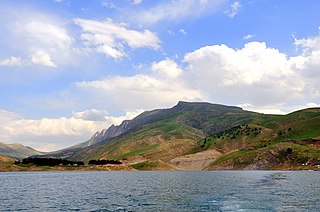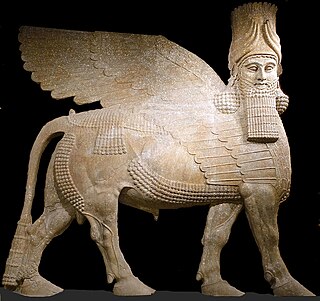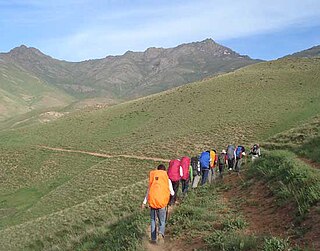Akkadian Period (Simurrum)
Stela of Iddi-Sin, King of Simurrum. It dates back to the Old Babylonian Period. From Qarachatan Village, Slemani Governorate, Iraqi Kurdistan. Located in the Slemani Museum, Iraq.

Zamua (also Mazamua) was an ancient Pre-Iranian kingdom, corresponding with the earlier kingdom of Lullubi, [1] which stretched from Lake Urmia to the upper reaches of the Diyala River, roughly corresponding with the modern Sulaimania governorate (still called Zamua/Zamwa ) in Iraqi Kurdistan. It was centered at Sharazur plain. Ameka and Arashtua were two southern Zamuan kingdoms. A tribal chief (Nasiku) bearing the Akkadian name of Nūr-Adad was a Zamuan leader who launched a failed resistance against Assyrian domination. Its inhabitants were most probably related to the Gutians living east and south of Zamua, and the Hurrians living northwest of the Kingdom.
The northern regions of Zamua (towards lake Urmia) were known as Inner Zamua. Ida was the most important state in Inner Zamua, with Nikdera one of its most important rulers.
Stela of Iddi-Sin, King of Simurrum. It dates back to the Old Babylonian Period. From Qarachatan Village, Slemani Governorate, Iraqi Kurdistan. Located in the Slemani Museum, Iraq.

In the Neo-Assyrian Period, Mazamua was an Assyrian province with the provincial capital of the same name Mazamua (modern Suleimaniya). [2] Lake Zeribar was considered by the Assyrians as Inner Mazamua. The region of Slemani was known as Zamwa prior to the foundation of the modern city in 1784. It is surrounded by the Azmar (Ezmer), Goizha (Goyje) and Qaiwan (Qeywan) Mountains in the northeast, Baranan Mountain in the south and the Tasluja Hills in the west. The city has a semi-arid climate with very hot dry summers and cold wet winters.
A letter is known where Sargon II speaks to Šarru-emuranni, his governor of Mazamua. [3]

Iraq, a country located in West Asia, largely coincides with the ancient region of Mesopotamia, often referred to as the cradle of civilization. The history of Mesopotamia extends back to the Lower Paleolithic period, with significant developments continuing through the establishment of the Caliphate in the late 7th century AD, after which the region became known as Iraq. Within its borders lies the ancient land of Sumer, which emerged between 6000 and 5000 BC during the Neolithic Ubaid period. Sumer is recognized as the world’s earliest civilization, marking the beginning of urban development, written language, and monumental architecture. Iraq's territory also includes the heartlands of the Akkadian, Neo-Sumerian, Babylonian, Neo-Assyrian, and Neo-Babylonian empires, which dominated Mesopotamia and much of the Ancient Near East during the Bronze and Iron Ages.

Kurdistan, or Greater Kurdistan, is a roughly defined geo-cultural region in West Asia wherein the Kurds form a prominent majority population and the Kurdish culture, languages, and national identity have historically been based. Geographically, Kurdistan roughly encompasses the northwestern Zagros and the eastern Taurus mountain ranges.

The Kurds are an Iranian ethnic group in the Middle East. They have historically inhabited the mountainous areas to the south of Lake Van and Lake Urmia, a geographical area collectively referred to as Kurdistan. Most Kurds speak Northern Kurdish Kurmanji Kurdish (Kurmanji) and Central Kurdish (Sorani).

Alqosh is a town in the Nineveh Plains of northern Iraq, a sub-district of the Tel Kaif District situated 45 km north of the city of Mosul.

Urmia is the largest city in West Azerbaijan Province of Iran. In the Central District of Urmia County, it is capital of the province, the county, and the district.

Sulaymaniyah or Slemani, is a city in the east of the Kurdistan Region of Iraq and is the capital of the Sulaymaniyah Governorate. It is surrounded by the Azmar (Ezmer), Goizha (Goyje) and Qaiwan (Qeywan) Mountains in the northeast, Baranan Mountain in the south and the Tasluja Hills in the west. The city has a semi-arid climate with very hot dry summers and cold wet winters.

Mannaea was an ancient kingdom located in northwestern Iran, south of Lake Urmia, around the 10th to 7th centuries BC. It neighbored Assyria and Urartu, as well as other small buffer states between the two, such as Musasir and Zikirta.
Suret, also known as Assyrian, refers to the varieties of Northeastern Neo-Aramaic (NENA) spoken by Christians, namely Assyrians. The various NENA dialects descend from Old Aramaic, the lingua franca in the later phase of the Assyrian Empire, which slowly displaced the East Semitic Akkadian language beginning around the 10th century BC. They have been further heavily influenced by Classical Syriac, the Middle Aramaic dialect of Edessa, after its adoption as an official liturgical language of the Syriac churches, but Suret is not a direct descendant of Classical Syriac.

The Jewish Neo-Aramaic dialect of Urmia, a dialect of Northeastern Neo-Aramaic, was originally spoken by Jews in Urmia and surrounding areas of Iranian Azerbaijan from Salmas to Solduz and into what is now Yüksekova, Hakkâri and Başkale, Van Province in eastern Turkey. Most speakers now live in Israel.

Al-Hasakah Governorate is one of the fourteen governorates (provinces) of Syria. It is located in the far north-east corner of Syria and distinguished by its fertile lands, plentiful water, natural environment, and more than one hundred archaeological sites. It was formerly known as Al-Jazira Province. Prior to the Syrian Civil War nearly half of Syria's oil was extracted from the region. It is the lower part of Upper Mesopotamia.

Upper Mesopotamia constitutes the uplands and great outwash plain of northwestern Iraq, northeastern Syria and southeastern Turkey, in the northern Middle East. Since the early Muslim conquests of the mid-7th century, the region has been known by the traditional Arabic name of al-Jazira and the Syriac variant Gāzartā or Gozarto (ܓܙܪܬܐ). The Euphrates and Tigris rivers transform Mesopotamia into almost an island, as they are joined together at the Shatt al-Arab in the Basra Governorate of Iraq, and their sources in eastern Turkey are in close proximity.

The Little Zab or Lower Zab is a river that originates in Iran and joins the Tigris just south of Al Zab in the Kurdistan region of Iraq. The Little Zab is approximately 400 kilometres (250 mi) long and drains an area of about 22,000 square kilometres (8,500 sq mi). The river is fed by rainfall and snowmelt, resulting in a peak discharge in the spring and low water in the summer and early fall. Two dams built on the Little Zab regulate the river flow, providing water for irrigation and generating hydroelectricity. The Zagros Mountains have been populated since at least the Lower Palaeolithic, but the earliest archaeological site in the Little Zab basin, Barda Balka, dates to the Middle Palaeolithic. Human occupation of the Little Zab basin has been attested for every period since then.

Muṣaṣir, in Urartian Ardini was an ancient city of Urartu, attested in Assyrian sources of the 9th and 8th centuries BC.

The Assyrian homeland, Assyria, refers to the homeland of the Assyrian people within which Assyrian civilisation developed, located in their indigenous Upper Mesopotamia. The territory that forms the Assyrian homeland is, similarly to the rest of Mesopotamia, currently divided between present-day Iraq, Turkey, Iran and Syria. In Iran, the Urmia Plain forms a thin margin of the ancestral Assyrian homeland in the north-west, and the only section of the Assyrian homeland beyond the Mesopotamian region. The majority of Assyrians in Iran currently reside in the capital city, Tehran.

The history of the Assyrians encompasses nearly five millennia, covering the history of the ancient Mesopotamian civilization of Assyria, including its territory, culture and people, as well as the later history of the Assyrian people after the fall of the Neo-Assyrian Empire in 609 BC. For purposes of historiography, ancient Assyrian history is often divided by modern researchers, based on political events and gradual changes in language, into the Early Assyrian, Old Assyrian, Middle Assyrian, Neo-Assyrian and post-imperial periods., Sassanid era Asoristan from 240 AD until 637 AD and the post Islamic Conquest period until the present day.

Erbil, also called Hawler, is the capital and most populated city in the Kurdistan Region of Iraq. The city is in the Erbil Governorate.
Sidekan also called Bradost, is a vast subdistrict belonging to Soran District (Diana-Rawanduz) north of Erbil in Kurdistan Region, with 250 villages. The district also contains the area where the ancient Armenian city of Mahkert was. Sidekan has a population of less than 15,000. The exact number of Bradostian people estimated is more than this census but as the original inhabitants had been deported three times in 1961, 1978, and 1988 and a lot of them have not yet returned due to the frequent bombing by the Turkish and Iranian militaries on the Kurdistan Workers Party strongholds in Khakurk mountains, and also because of the lack of renovation projects by the local authorities.
Since the early 20th century several proposals have been made for the establishment of an autonomous area or an independent state for the Syriac-speaking modern Assyrians in northern Iraq.

West Azerbaijan province is one of the 31 provinces of Iran, whose capital and largest city is Urmia.

Mount ChlChama is a part of the Zagros mountains, which are located in Iran, between the cities of Saqqez, Divandarreh and Marivan in Kurdistan province. The highest peak of Chlchama, also known as Chlchama, is 3,173 metres above sea level, near the villages of Isakawa and Kanemat, 56 kilometres southwest of Saqqez.